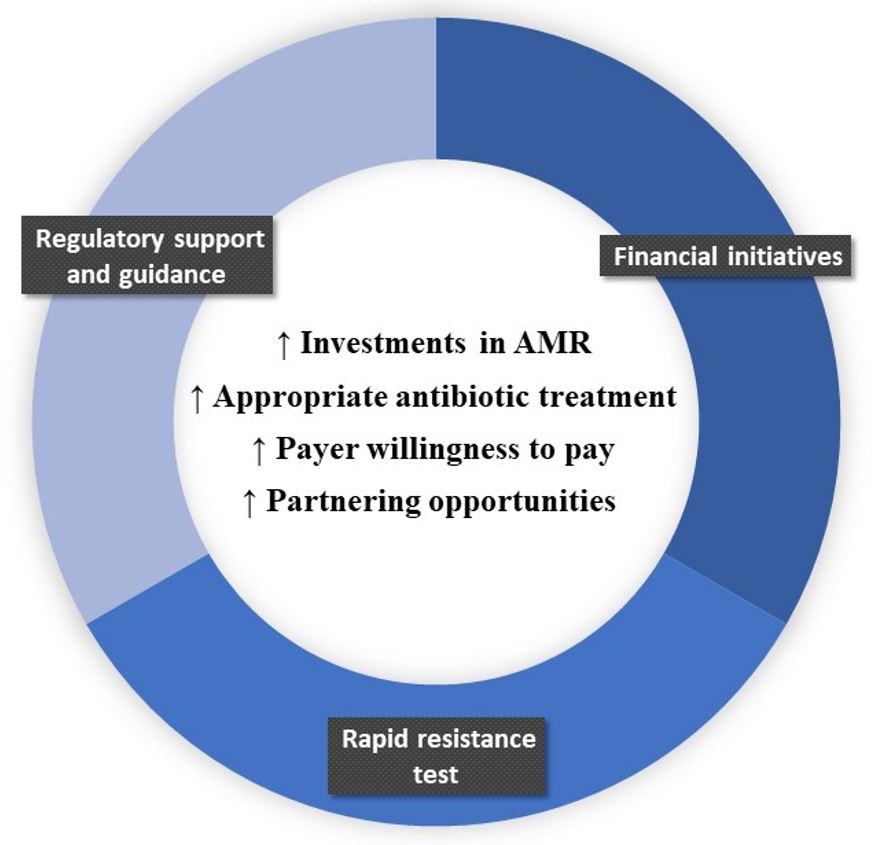Financial possibilities for future antibiotics
Antibiotics presently on the market have low cost as they are old and without patent-protection. Society at large thus expects also new antibiotic drugs to be cheap. This is one of the major reasons for Big Pharma to avoid prioritizing development of new antibiotic drugs – it has simply not been profitable. There are, however, several recent initiatives that will contribute to making development of new antibiotic drugs profitable again. This will also be profitable for society as hospital costs are rapidly increasing due to resistant bacteria.
Financial incentives One recent opportunity is the AMR Action Fund which was presented in July 2020. Several Big Pharma, WHO, The Development Bank, Wellcome Trust, Bill and Melinda Gates Fund and others have created this fund, which will invest 1 billion USD during 5 years to support clinical development of novel antibiotics. The AMR Action Fund will initially invest in 15-20 projects. Investments will be via equity stake or equity-like securities and the AMR Action Fund will provide companies with access to capabilities and expertise. The goal is that its investments will result in 2-4 new antibiotics by 2030. ULT2A and ULT2C both have a short way to the market and could be ready 2030.
The AMR Action Fund is a clear sign that the situation for development of new antibiotics is improving. It is likely that pharma companies will regain their interest in licensing patent rights to antibiotic projects with new compounds. This would in particular apply to those active against infections caused by pathogens in the priority lists of WHO and CDC. Ultupharma judges that the ULT2 program meets the requirements for applying for funding from AMR Action Fund. Such funding could be sought by a partner, together with a partner, or by an expanded and strengthened Ultupharma.
Another interesting possibility is a new financial model for companies developing new antibiotics, as proposed in the DRIVE-AB Final Report. This model is composed of “push” and “pull” incentives including market entry rewards of 1 billion USD. If this initiative is launched, all Ultupharma´s projects could potentially benefit from this.
Two examples of interesting "pull" incentives are Transferable Exclusivity Extension (TEE) and subscription models. TEE could be a way to make Big Pharma interested in new antibiotics as this could prolong patents on other products. Subscription models would be based on offering antibiotic developers upfront payments in exchange for access to their antibiotics, and this type of model is a central part of The PASTEUR Act. Beam Alliance has proposed pull incentives mechanisms including both TEE and subscription models.
Rapid diagnostic tests Further, technical development of rapid diagnostic methods for determination of the susceptibility of pathogenic bacteria to antibiotic drug may prove crucial to make new antibiotics profitable again. New technology for rapid (15-30 minutes) susceptibility determination of active bacterial infections in clinical settings is likely to come. When in place, it will enable the selection of the best antibiotic treatment from the start, even if this treatment may be highly priced. This practise will save lives when it comes to patients with life-threatening systemic infections. This will make it possible for pharmaceutical companies to develop new antibiotic drugs, and to cover the very high developmental costs. Rapid diagnostic tests can also be used by asymptomatic persons to identify if they carry H. pylori and then have the option to get rid of this pathogen.
Regulatory support and guidance Moreover, the clinical development of a new antibiotic drug may now be substantially cheaper and faster as FDA has issued a new guidance, LPAD (Limited Population Pathway for Antibacterial and Antifungal Drugs). Approval under the LPAD pathway may be supported by a streamlined clinical development program, and may involve smaller, shorter or fewer clinical trials. This opportunity is clearly relevant for the Ultupharma projects.
Orphan designation is a tool that was developed to facilitate the development and authorization of pharmaceutical drugs aimed to treat rare diseases or conditions (<200 000 patients in the US and <5 in 10 000 people in the EU). Several indications for ULT2 fulfil the orphan criteria. Projects with orphan designation benefit from several incentives, such as protocol assistance from the authorities, reduced fees and protection from competition following marketing authorization.
New and very large markets for antibiotics as cancer prophylaxis, by H. pylori removal, is probably the presently largest financial possibility for new antibiotics, as described in New Markets. Removal of H. pylori may also reduce risk for Alzheimer's disease and Parkinson's disease.
